Dragons — oh, I’ve killed dragons. Lots of dragons. I’ve collected dragon scales, I’ve made weapons out of dragon bones. I’ve even been able to speak the language of dragons. You’d think I’ve done it all, but no: before playing Crimson Dragon, I had never ridden a dragon before.
This also means I’ve never played Panzer Dragoon — and as some of you know, Crimson Dragon could be said to be a spiritual successor to that series. Crimson Dragon does, after all, have some of the folk that were on the Panzer Dragoon team. And Crimson Dragon is also a rail shooter like Panzer Dragoon. This means that you fly out into the battle with your trusty dragon in the game, and though you are able to move your dragon around and dodge incoming attacks with the left stick, the dragon largely chooses the flight path for you.
This set-up means you’re free to worry about defeating the fearsome creatures of Draco, a planet that humans have colonized. Though plot is not exactly Crimson Dragon’s strong suit, basically, there’s a mysterious virus that plagues the land, a government that is too cagey to tell its citizens what is going on with the origin of that virus, and to top all that off, there’s also a ginormous dragon that’s causing a lot of trouble. That dragon may be connected to the virus.
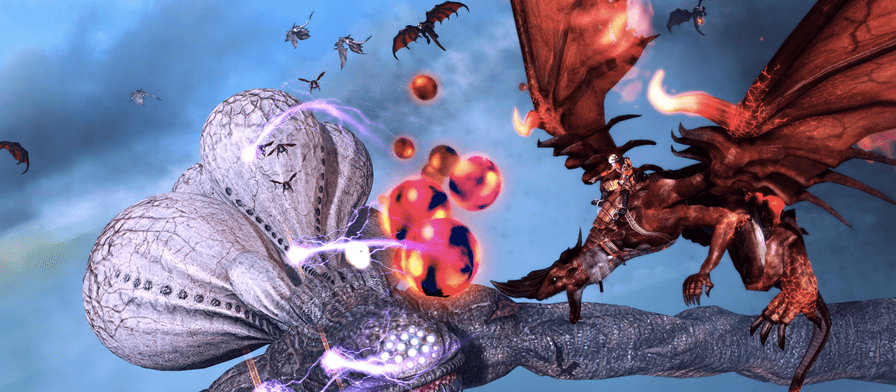
You learn a bit more about that stuff every time you go out on missions as part of an elite force of dragon riders. Though you are a rookie, at the start of the game you get to choose between a couple of dragons. You’ll want to go with whatever best fits your playstyle — I went with the dragon that was less agile, but packed more power. Though an in-game stats screen told me so, it was cool to actually feel that be the case: the right trigger on the Xbox One controller, which you use to shoot, emitted a deep rumble every time I shot my main attack. This is the most ‘next-gen’ feature in the entire game — a small and appreciated detail, but a tad underwhelming in the context of thinking about new consoles that should offer fresh experiences.
As you go along, you unlock more dragons that you can purchase, all with their own strengths and weaknesses. You can also equip different abilities, all of which make your dragon shoot differently. There are powers that manifest themselves as slow but potent energy blobs, as well as powers that are short and staggered bursts of energy, and some powers can even lock on to your enemies — just to describe a few abilities. It’s all standard fare, as far as shoot ’em ups go. All of these powers have elemental affinities, and depending on what you’re facing, you can switch up your powers to have an advantage against enemies. Unfortunately, how these affinities interact with each other isn’t really explained very well — causing me to go with random powers for much of the game.
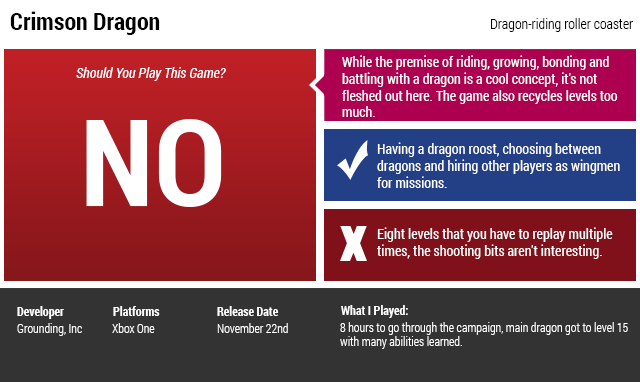
Missions take place in one of seven levels — and this is one part of the problem with Crimson Dragon. Though it is a budget title, spending hours playing through the same handful of locations that only kind of switch up where the enemies are is, well, boring and rote. The game doesn’t start off feeling that way, though. At first I was excited by how awesome an idea dragon riding combined with dragon customisation is. The opening levels also feature worlds that vaguely remind me of Avatar, with lush alien jungles and strange creatures I’d never seen before. Nothing on par with some of the more beautiful graphics that this new generation has to offer, but, y’know. It’s not an ugly game, either. Because of this, I started out wanting to get lost in this world.
But not only does the novelty of the occasional cool level wear off after the game requires you to play through the same locale multiple times for different missions, it also doesn’t feel challenging. You can play on either classic mode or casual mode — and all this really means is that there is an easy mode, and a mode where enemy attacks flood the screen. Surviving the latter classic mode nets you a bonus at the end of the level. Regardless of which mode you choose, the game often lets you move forward regardless of how many enemies you kill.
While ostensibly this could then mean that motivated players can go after high scores and more casual players can relax and just go with the flow, I seemed to get good scores no matter how well or badly I did in classic mode. If I stopped caring about scores, then I had to deal with how repetitive playing through the same levels felt. That’s the case even when you’re playing through completely different levels: early on, you play through a lake level. Later, you play through a lava level. The boss at the end of the level? It was the same giant eel thing. Except, you know, a different element. Big whoop. Never mind that the lava level felt like a reskin of the water/lake level, or that enemies often reappear across different locales. Too much feels recycled in Crimson Dragon.
The way the missions themselves go down isn’t particularly interesting after you’ve played through a level once, too. There are four types of major objectives: kill as many things as you can, collect as many beacons (this game’s version of coins scattered about a level), take no damage in a section, and survive for X number of seconds/minutes. Sometimes, these objectives will switch up a bit, too — you might have to collect beacons while also shooting down enemies, for instance — but for the most part, you’ll only be doing one at a time. Despite revisiting levels to achieve slightly different goals every time, missions/levels still feel samey. The objective of killing everything in a level is much like the objective of avoiding damage in that level, because I’m still killing and dodging as much as I can in both situations. Collecting all the beacons is much like surviving for a certain amount of time: I want to stay alive in both scenarios, and I’m still flying through the same section again.
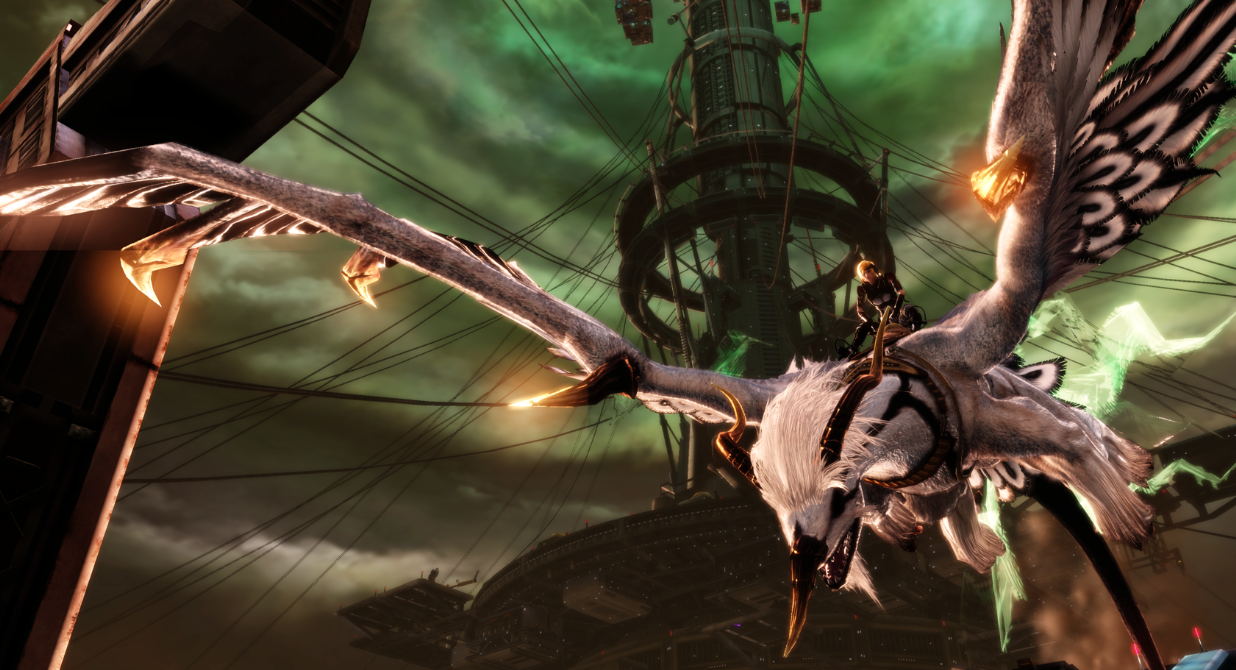
I think I would have been fine with all of that had the dragon raising sections been fleshed out. Your dragon can gain experience and levels, but this feels meaningless given the difficulty of the game. You can feed your dragon, but all this means is choosing something on a menu…you don’t get to see or hear your dragon eat anything. You just watch an experience bar go up, I guess. I still maintain that having a dragon roost is exciting, but the potential seems squandered in Crimson Dragon. Despite spending eight hours with my beast, I don’t feel like I got close to my dragon, or like I bonded with my dragon much at all. That’s kind of jarring when you consider that the game’s fiction often touches on the bond between rider and dragon. Really, the only reason I stuck with a particular dragon is because I’d already taught it a few different abilities — why start over with a different dragon? I certainly didn’t want to spend time replaying missions to level a new dragon, either.
The best part of the game is being able to enlist the help of ‘wingmen,’ which basically means going through a level with another dragon — and the dragons all belong to other players. Starting out, for example, I rode with the dragon belonging to Ben Kuchera, from Penny Arcade Report. With that dragon’s help, I breezed through levels even more easily than I would have on my own. It’s a feature that makes you feel like Crimson Dragon’s world is bigger than what you get to experience. Neat!
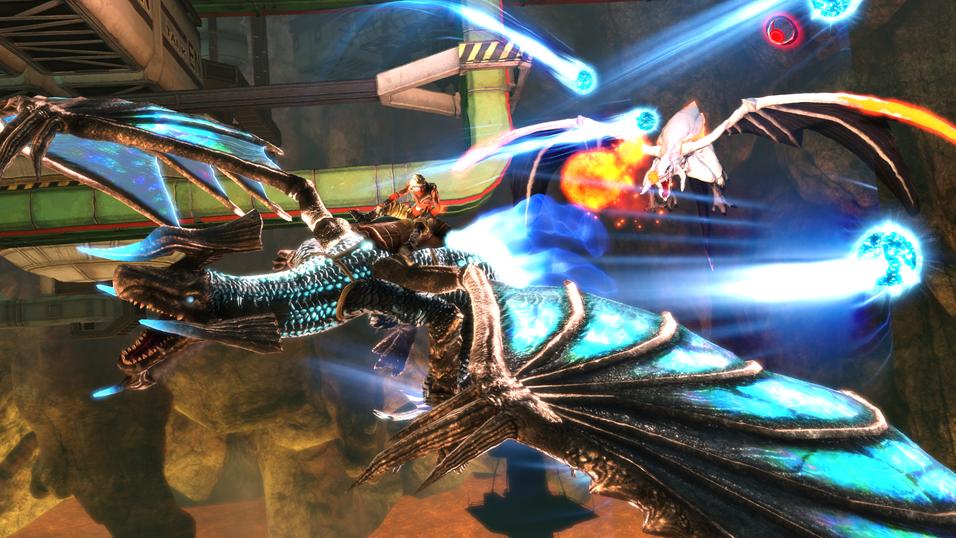
I should note that hiring other wingmen costs credits — and you gain credits as you complete objectives in levels. Credits also allow you to purchase other stuff in the game’s store, too. The store contains revival crystals which let you continue a level without starting over when you die, ampoules, which are attribute boosting items you can equip before a level, and jewels which help you upgrade your dragon. And as you might’ve guessed, you can in fact spend real-world cash to get some of this stuff, too. I spent no money, though — heck, I barely used the store at all. I stuck with the same dragon for most of the game. You can buy revival gems once you actually die, and jewels can only be acquired via actual money. Eh.
If I haven’t really mentioned the Kinect controls thus far, it’s because I opted to not use them for most of the game. You can navigate the menu through voice commands, though the Kinect doesn’t seem to always understand what you’re saying. And while you can tilt to the left or right to make your dragon barrel roll in that direction, I found that either the Kinect didn’t always pick the motion up, or it would happen too slowly — causing my dragon to take damage. And if it did pick the motion up, it would only happen if the motion was kind of exaggerated — which could often throw me off my groove while playing. I suspect that most people who try Crimson Dragon won’t be using the Kinect much.
Riding a dragon isn’t something I’ve experienced until recently — I should be excited that I finally got to do it in Crimson Dragon, but instead I mostly felt boredom while playing.
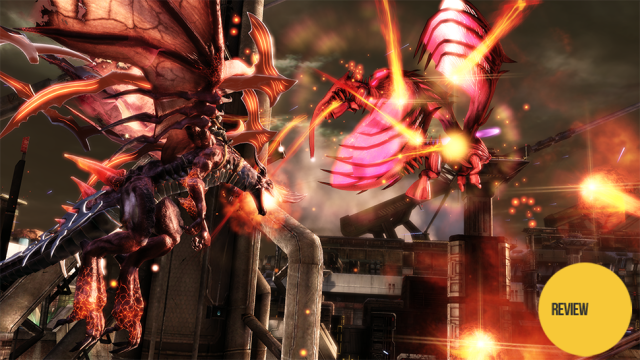
Comments
6 responses to “Crimson Dragon: The Kotaku Review”
Is there a reason why none of the other X1 game reviews (Killer Instinct, Dead Rising 3) have been posted on Kotaku AUS?Embargo’s lifted early this morning and almost every other site has had theirs up, including your US counterpart.
Nevermind, they’re up.
My guess: they’ll be imported shortly. there’s usually a bit of a delay between the US site and the AU site.
Any reason why any of that needed to be spoiler tagged?
It didn’t originally but as the reviews went up, and there’s no way to delete a comment, I figured that would be the next best thing.
This is an arcade game and not a full title? I just quickly eye balled the review
Disappointed by the reviews, being a Panzer Dragoon fan I was really looking forward to this. Still might get it though